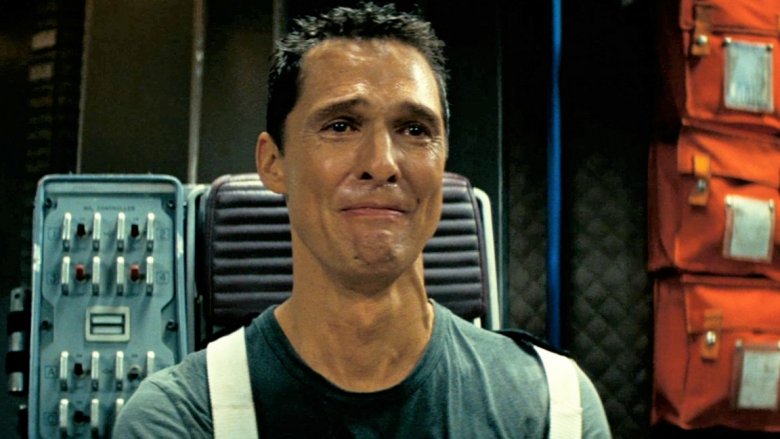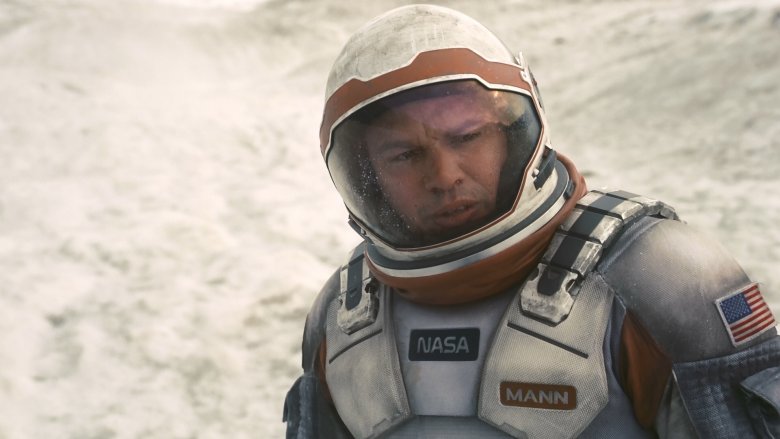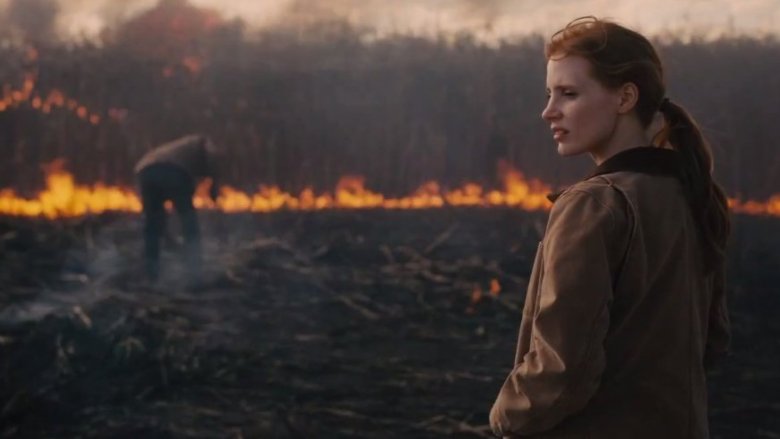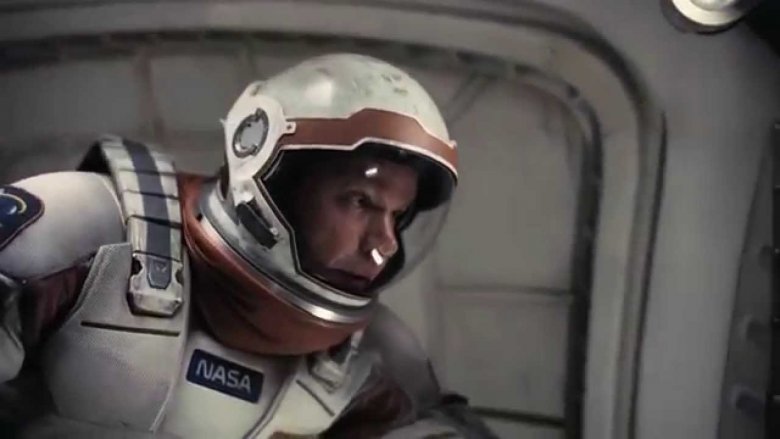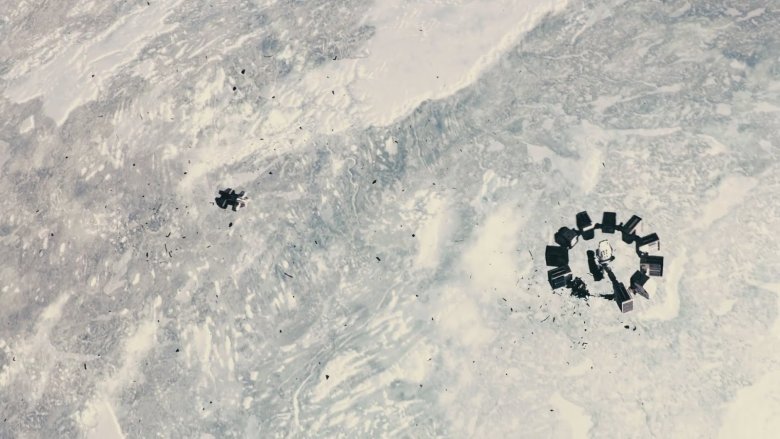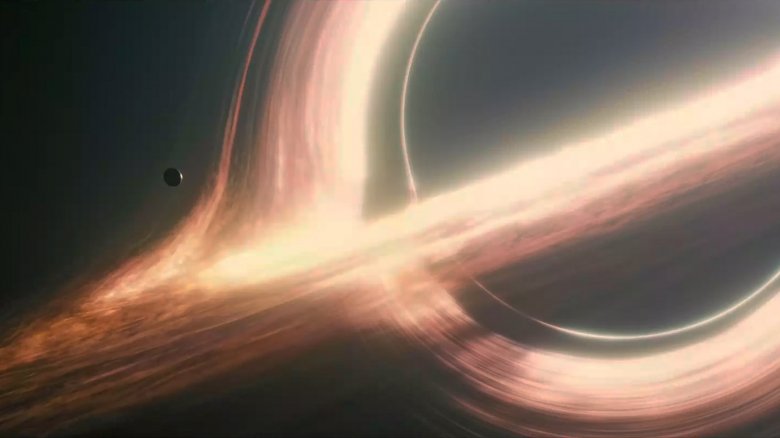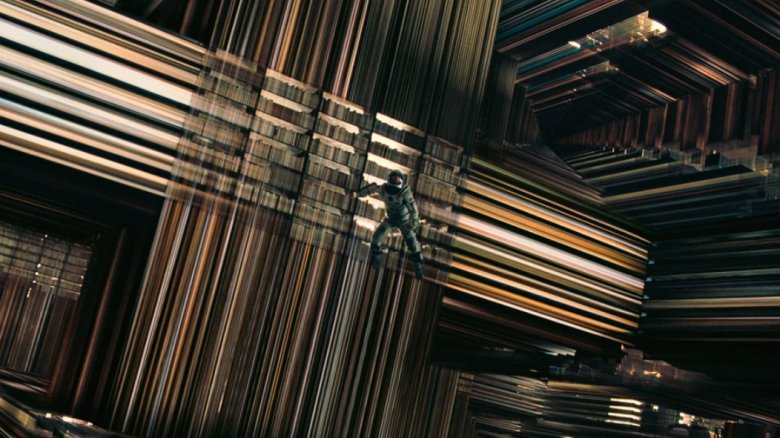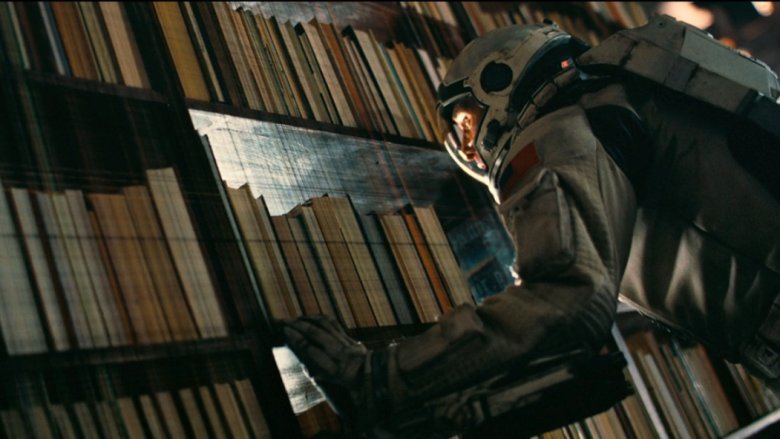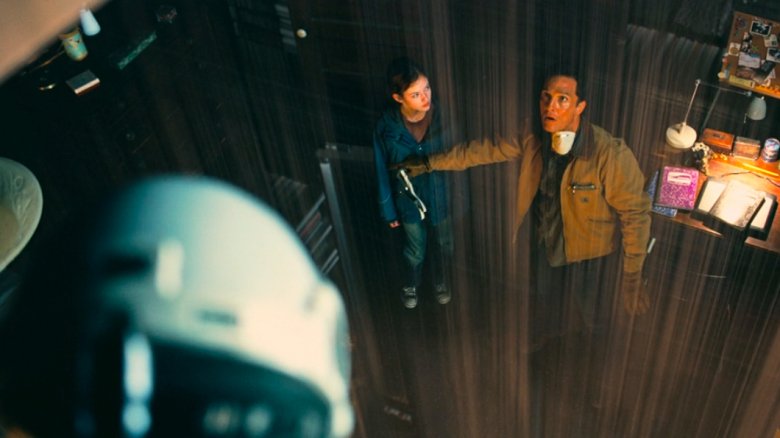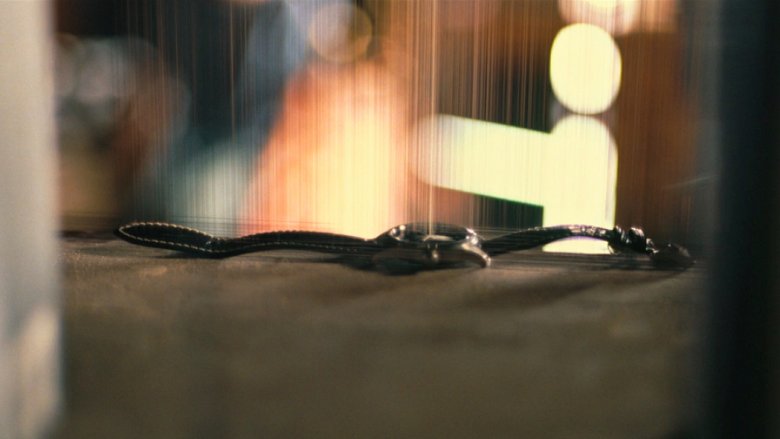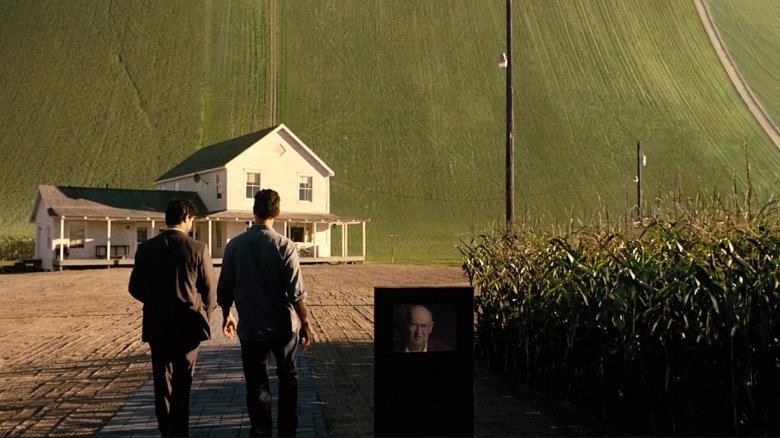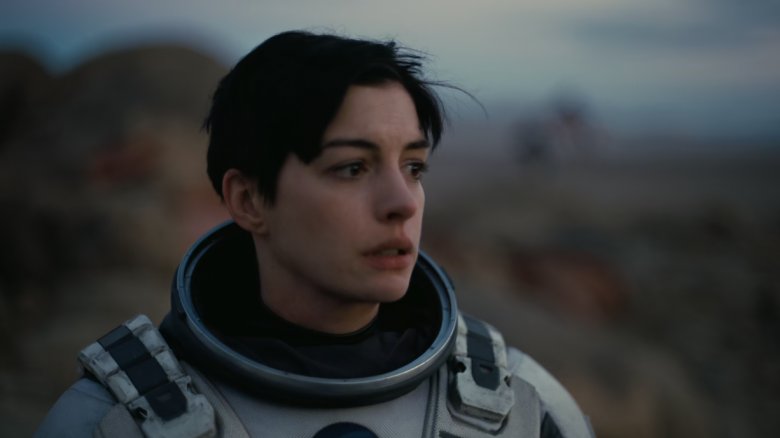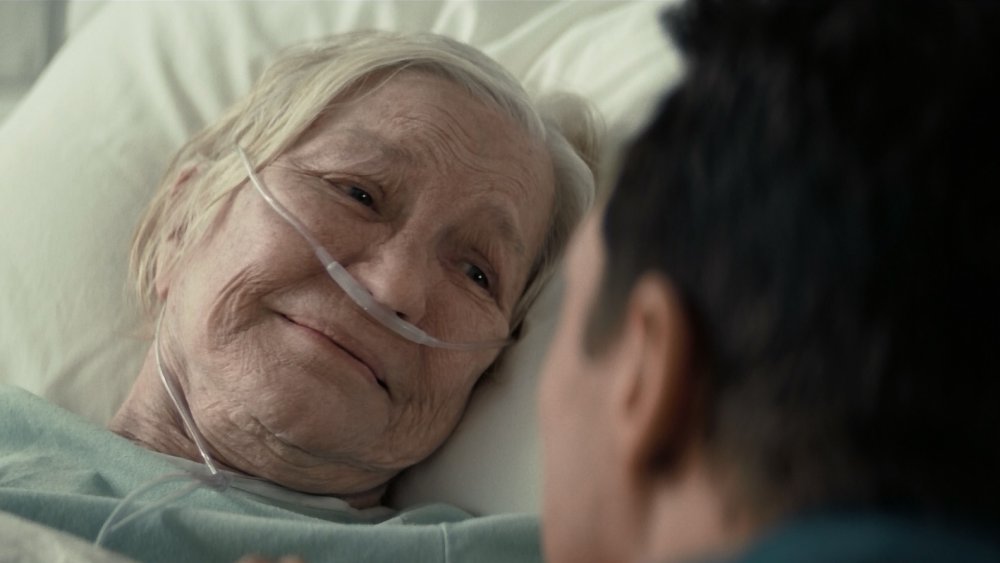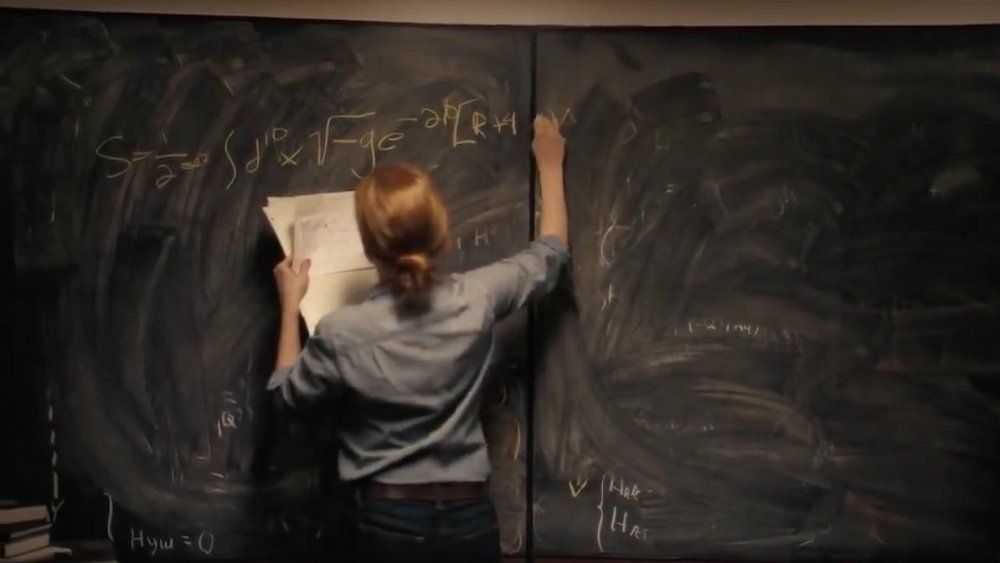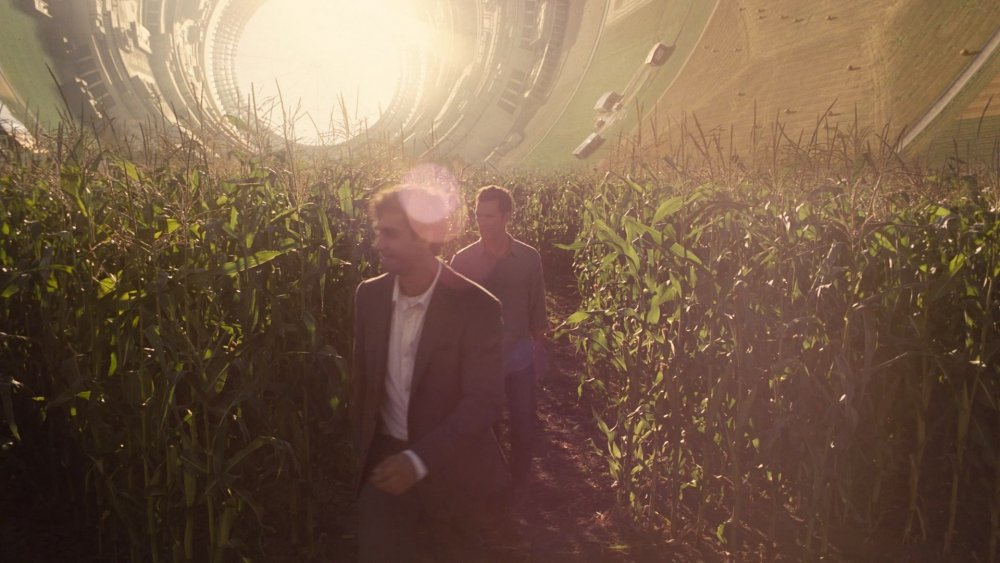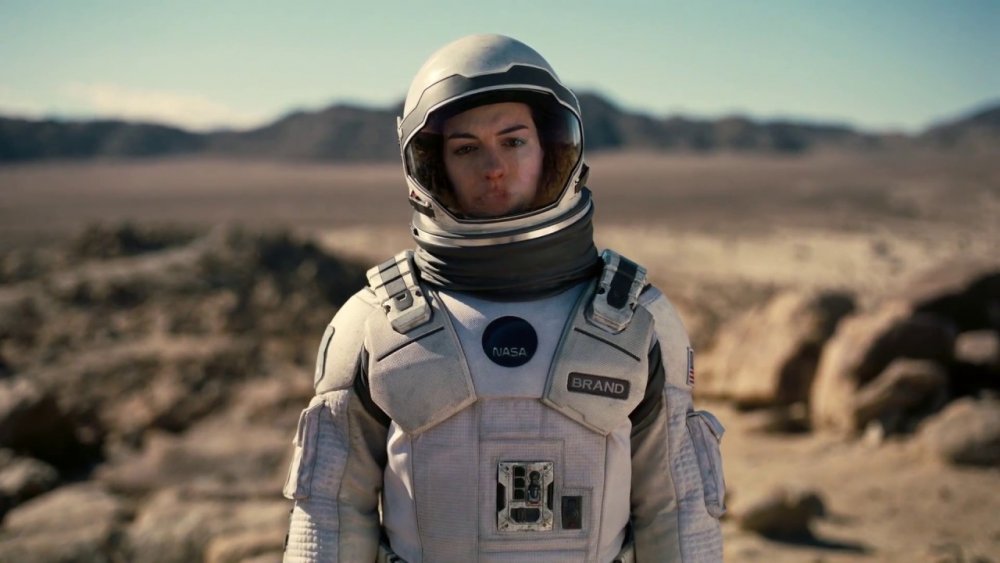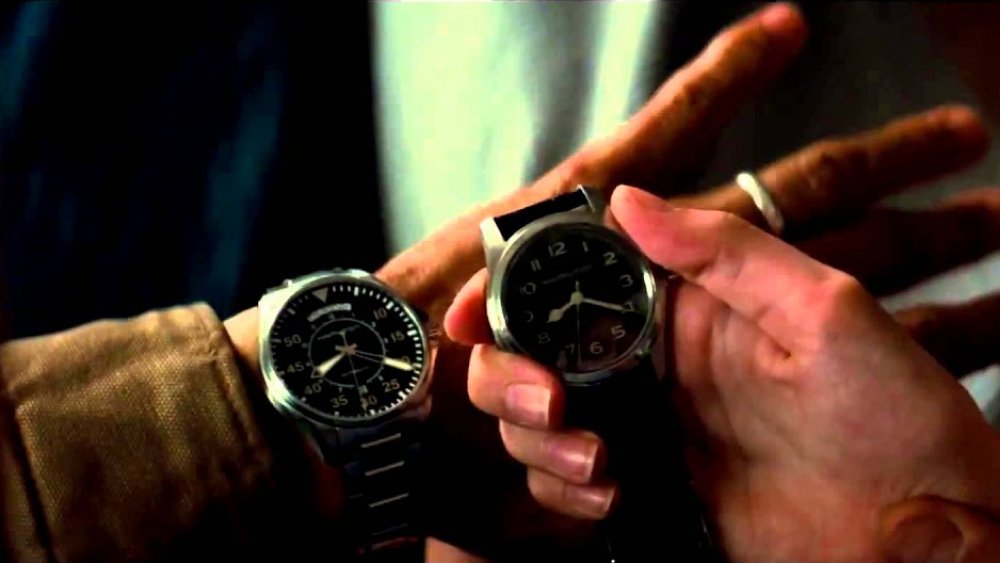The Ending Of Interstellar Explained
Christopher Nolan has never been one to shy away from unconventional narratives and complex story structures, whether that means telling a story backwards in Memento, questioning our perceptions of reality and time in Inception, or poking at the nature of identity and individualism in The Prestige. So when he released his time-slipping space epic, Interstellar — a tale about humanity's efforts to escape a dying Earth for a new home in the stars — it shouldn't have come as a surprise when it was anything but straightforward.
Even if you're mostly able to follow the movie through its first two hours of wormholes, gravitational propulsion theory, and the relativistic passage of time, we wouldn't blame anybody if they got lost in the film's final hour. Not only does every major theme and theory of the film come to a head as the story builds towards its climax, but it also throws a major curveball at the audience in the form of an infinite, interdimensional library that literally comes out of nowhere.
Fortunately, if you've been having trouble making sense of what happens at the conclusion of the film, we've got answers. Below, we do our best to walk through the bizarre, mind-bending ending of Interstellar.
What was Dr. Mann trying to do in Interstellar?
Life on Earth isn't great in Interstellar. Massive dust storms are tearing up the planet, crops are failing, and soon, humanity will cease to exist. Looking for answers, NASA turns to the skies, hoping for an answer.
As we learn at the beginning of the film, a group of 12 scientists traveled through a mysterious wormhole that appeared near Saturn, to see if the 12 planets on the other side could sustain human life. A few years later, the Endurance and its crew — including Cooper (Matthew McConaughey) and Brand (Anne Hathaway) — are going to visit the three most promising planets in the hopes of colonizing one. When they arrive on Dr. Mann's (Matt Damon) planet, the heroic scientist assures them his icy cold spot is the perfect place for humans to live.
Unfortunately, it's soon all revealed to be a ruse. Although each of the original 12 scientists knew their trip was one-way, Mann admits he never fully considered the possibility that his planet would be uninhabitable, and that he might die alone. Although he resisted the urge for years, he eventually falsified his survey data in order to coax another team to travel to his planet, intending to use the Endurance to escape. At this point, Mann is so desperate to leave that he'll do anything, even commit murder. Paranoid that the Endurance crew won't go along with his plan once they learn what he's done, Mann attempts to kill Cooper so he can make his getaway. Yeah, it's a murderous Matt Damon, which we don't often get to see on-screen.
Why does Murph burn Tom's fields?
Back on Earth, Cooper's now-grown children find themselves at odds. His daughter, Murph (Jessica Chastain), has realized the surface of our planet has become uninhabitable. So naturally, she's trying to persuade her brother, Tom (Casey Affleck), to bring his family to the secret NASA facility where she's been working on the gravitational equation that would allow humanity to escape into space en masse. But despite Murph's warnings (and the fact that his son is really sick), Tom refuses to abandon the farmhouse where he and Murph grew up. After Cooper left them in their grandfather's care when they were children, never to be heard from again, Tom lost all faith in NASA's ability to help them.
Convinced her brother is making a terrible mistake, Murph sets fire to Tom's corn fields, knowing that since Tom relies on his crops for survival, he'll be forced to drive out to try to extinguish the blaze. That buys Murph enough time to return to the house and evacuate Tom's wife and son, likely in the hopes that once Tom realizes his family has gone to the NASA facility, he'll have no choice but to join them. Hey, desperate times call for desperate measures. But Murph's involvement in the story is far from being over.
How does Mann's plan go wrong?
In order to keep anyone from discovering that he'd falsified his survey data until after his escape, Mann sabotaged and booby-trapped his robot that had been storing the fake data. Mann's tampering leads to a massive explosion, but Endurance robot TARS is able to escape. Better still, TARS reveals that he's disabled the automatic docking procedure for the shuttles, which means that even though Mann has stolen Cooper's shuttle, he's unable to dock with the Endurance.
Meanwhile, Cooper survived Mann's attempt to kill him long enough to call for help, and Brand picks him up in the second Endurance shuttle. Although Brand and Cooper caution Mann that attempting to manually dock with the Endurance won't work, the scientist tries anyway, determined to escape his planet by any means necessary. But as soon as he attempts to depressurize the shuttle's airlock so he can enter the Endurance, the airlock explodes, killing Mann and sending the Endurance into a rapid spin.
With the help of TARS and the other Endurance robot, CASE, Cooper is eventually able to successfully dock with Endurance and stabilize the spin. But by that point, the ship is severely damaged and lacks enough fuel to travel anywhere safe, leaving Cooper and Brand effectively stranded in space. Talk about a rough day on the job.
What is Cooper's plan to get to Edmunds' planet?
Without enough fuel to either return to Earth or travel to the third potentially habitable planet (colonized by a scientist named Edmunds), Cooper proposes to use the gravity of the black hole Gargantua to execute a slingshot maneuver, which would send the Endurance off with enough inertia to reach Edmunds' planet. However, as was established earlier in the film, every time the Endurance crew approaches the black hole, its gravitational field distorts their perception of time due to relativity, meaning what they experience as only minutes passes as years for anyone outside Gargantua's gravity.
By executing Cooper's slingshot maneuver, he and Brand will experience "time slippage" of 51 years. They both realize this means Cooper will have to give up hope of ever seeing his children back on Earth, as they will likely have died of old age by the time the Endurance exits Gargantua's gravity. Still, Cooper knows that his plan is humanity's last chance for survival.
Adding even more drama to Cooper's decision is Mann's earlier speech about the moment humans experience before death. According to Mann, as our brains grasp at survival, we'll experience a vision of the thing we most desire to see again. Mann speculates that Cooper's final image will be of his children, since they're his reason for living. By giving up hope of seeing his children again, Cooper is prioritizing the future of humanity over his own motivations for survival.
Why do TARS and Cooper get pulled into Gargantua?
With its depleted fuel supplies, in order for the Endurance to pull free of Gargantua's gravity after completing Cooper's slingshot maneuver, the ship has to decrease its weight. Before beginning the maneuver, Cooper decides the shuttle holding TARS will detach and drop into the black hole. In addition to relieving the Endurance of the shuttle's weight, Cooper hopes that TARS can collect the quantum data from inside the singularity that NASA scientists on Earth need to complete the gravitational equation that will allow humanity to leave. While odds are slim that TARS will be able to transmit this data back to Earth, Cooper is determined to at least try, since it's his children's last hope of survival.
However, Cooper doesn't tell Brand that losing TARS' shuttle won't account for a big enough drop in weight. In fact, an additional shuttle has to detach in order for the Endurance to escape. Cooper decides that he should bite the proverbial bullet, leaving Brand to continue on to Edmunds' planet and restart the human race with a whole bunch of embryos on board the Endurance. He doesn't tell Brand until the last moment because he knows she would argue with his decision, but even without the possibility of seeing his children again, Cooper is at peace with his probable death.
How does Cooper survive the black hole, and where does he go?
After falling into the black hole, Cooper continues to record what he's seeing and transmits it back to TARS, hoping the additional data might help the scientists back on Earth. Although he expects to eventually get crushed by Gargantua's gravity, Cooper is miraculously spared once his shuttle is ripped apart. And that's when things get crazy. After surviving the wild ride, Cooper gets transported to an infinite, interdimensional library that allows him to look back into different moments in his daughter's childhood bedroom, including the day he left for his mission on the Endurance.
TARS determines that they made it through Gargantua alive because they were protected by "them," the mysterious beings who constructed the wormhole that allowed the Endurance to travel to this new galaxy in the first place. Since the beginning of the film, who "they" are has been a mystery. While NASA realized the wormhole (the one that shows up by Saturn, earlier in the movie) was artificially constructed by some sort of advanced intelligent beings, they didn't have any information about "them" beyond the assumption that they must be benevolent, since humanity's only chance at survival is due to the wormhole. TARS deduces "they" also must have built this library in order to help Cooper understand their five-dimensional reality. And sure, it's confusing, but it's also nice to have otherworldly beings on your side.
Why does Cooper see Murph in the black hole?
Although the library where "they" bring Cooper seems to go on forever, every part of this room serves as a window into the exact same place: his daughter Murph's childhood bedroom. At first, Cooper seems to think he's been brought to her because of his own desire to see her again, but TARS helps him understand "they" have constructed this three-dimensional reality for Cooper, allowing him to access all five dimensions in a way he can understand.
Together, TARS and Cooper figure out that through the library, Cooper is able to physically influence different points in space-time by using gravity to move things (time and gravity being the fourth and fifth dimensions that exist in "their" reality). But what's the point of all this? Well, Cooper deduces that he's been brought here to send a message back through time, using gravity, and that Murph has to be the one to receive it. Cooper realizes that while he thought "they" were fixated on him, he's not actually the one who's most important to saving humanity — Murph is. The library exists to ensure that Cooper will be able to deliver his daughter the information she needs, right when she needs it.
What is Cooper trying to do in Murph's room?
At first, when Cooper sees the young Murph, he tries sending her a message that he shouldn't leave on the Endurance, using the books on her shelf to spell out "S-T-A-Y" with Morse code. Cooper seems to think that if he can prevent himself from leaving Earth, he can somehow be reunited with his family, erasing all the years he missed with his children after departing on his journey. But as we saw at the beginning of the film, while young Murph (Mackenzie Foy) gets his message, she's unable to convince her father to stay. The library allows Cooper to perceive all five dimensions, but it doesn't allow him to change any of them. He can't rewrite time any more than he can stop being three-dimensional.
TARS realizes this, telling Cooper "they" didn't bring him to the library in order to change the past. Only then does Cooper accept the reality of his situation, and understand that he's not there to change things that have already happened. Instead, he's here to shape and influence the future. With TARS' help, he gives young Murph the coordinates to the NASA facility that led to his mission on the Endurance in the first place. Plus, he shares some info that might just save humanity.
So who are 'they' in Interstellar?
After Cooper finds himself stuck in the library, he realizes he's supposed to pass along the quantum data that TARS collected from inside Gargantua. The information the robot gathered from inside the black hole will help Murph save mankind, and Cooper is the interdimensional messenger, selected by the same mysterious forces that constructed this library and created the wormhole near Saturn. And once Cooper understands his new purpose, he realizes the creatures who've been assisting humanity aren't extraterrestrial at all. "They're not beings," he says. "They're us."
As it turns out, at some point in the future, humanity will advance to a point where we can navigate through all five dimensions. It's these future humans who used gravity to create the wormhole that allowed NASA to send scientists to explore the 12 planets in the first place. These future humans are also the ones who protected Cooper from the effects of Gargantua. Just as Cooper is able to use the library to influence events that, for him, already happened, the humans of the future have been using their understanding of time and gravity to ensure their own survival by assisting Cooper, Murph, NASA, and the other humans of their past.
What's love got to do with it?
After realizing why the library exists and that "they" want Cooper to give Murph the quantum data she needs to save the world, TARS asks how Cooper plans to communicate such complex information from another dimension. After considering it for a moment, Cooper tells TARS that love is the key. The robot doesn't understand, but Cooper explains that he can trust his love for his daughter to guide him to exactly where he needs to be. As Brand explained earlier in the film, love is the only thing that transcends all dimensions, including time and space.
Cooper decides to code the quantum data into the second hand of the watch he gave Murph before he left, assuring TARS that she will one day return for it. When TARS asks how Cooper can be sure, he responds, "Because I gave it to her," confident that her love for him will lead her where she needs to go, just as his love led him back to her.
Sure enough, as all this is happening, the adult Murph has indeed returned to her childhood bedroom, drawn by an unseen force. She suddenly understands the "ghost" from earlier in the film, the entity trying to contact her with dust patterns on her bedroom floor, was actually her father. Reminded of her love for him, she finds the watch, and voila, things are suddenly starting to look up for humanity.
What happens in Interstellar after Cooper delivers his message?
With the planet dying, humans need to evacuate the place fast. But to solve the gravitational equation that allows humanity to escape from the tethers of Earth, you need quantum data gathered from inside a black hole. Thinking that collecting such data is impossible, Murph believes the people of Earth are doomed, and that her father has abandoned her. However, once she realizes that Cooper was her childhood "ghost" and that he's given her the data she needs through the watch, she's able to solve the equation, ensuring humanity's survival.
Once Cooper passes along the quantum data, the tesseract (aka the library) begins to collapse, having served its purpose. Cooper loses consciousness, and he later wakes up on a space habitat orbiting Saturn. Just as "they" brought Cooper to a library and allowed him to communicate with his daughter and save humanity, "they" also brought him back back to safety once he was finished with his mission. Only instead of Earth, he's now on a gigantic colony floating through space. Thanks to Murph's calculations and the data acquired from the black hole, humans were finally able to leave Earth en masse, and now they're spread out over several different space habitats. And it's all thanks to those mysterious forces, who helped Cooper in the library and made sure people would find him once it was time for the library to close.
Where does Cooper go at the end of Interstellar?
Due to the "time slippage" that Brand warned about before executing the slingshot maneuver around Gargantua, at least 51 years have passed for the people of Earth (and possibly even more, since Cooper spent more time in the black hole than he factored into the slingshot calculation). However, it's only been hours for Cooper. By the time he makes it to the space habitat known as Cooper Station, his daughter Murph, whom he last saw as a little girl, is an old woman on the verge of death. On the flip side, Cooper appears to be about the same age as he was when he left.
While Cooper is overjoyed to finally be reunited with his daughter, Murph knows that she won't live much longer, and tells Cooper that he should go so that he doesn't have to watch her die. Cooper takes his daughter's advice and steals a ship, intending to head back through the wormhole and join Brand on Edmunds' planet. Like Cooper, she would've only recently arrived, and she'll soon be entering hyper-sleep, keeping her the same age until he reaches her.
Sadly, Edmunds himself has died at some point during the decades he spent waiting for NASA to send a team to his planet. But as Brand takes off her helmet and breathes in the air of her new home at his grave site, it's evident this is the planet the astronauts have been searching for, where humanity can rebuild and, eventually, thrive again.
How much time has passed for each character by the end of Interstellar?
Although we never learn exactly what year it is at the beginning of Interstellar, for the first half of the film, the timeline seems pretty straightforward. Even when the narrative begins easing into the concept of relativity — that gravity will cause some characters to experience time differently than others — it does so in baby steps. It's easy enough to understand how two years pass on Earth while only a few months go by for the hibernating crew of the Endurance, suspended in their cryosleep pods.
But once the Endurance hits the water planet, keeping track of time becomes much trickier. While Cooper and Brand only experience a few hours, the people of Earth, including Murph, live another 23 years. However, while Romilly is also in Earth-time, he goes into hibernation for a few long stretches, so he may have only aged a decade or so during those 23 years. By the time they leave the water planet, it's been a few months since departing Earth for Cooper and Brand, 25 years for Murph and NASA, and somewhere in between for Romilly.
The next big jump happens during the slingshot around Gargantua, after Romilly dies. While we never learn precisely how many years Cooper and Brand lose during their Hail Mary maneuver, it's probably somewhere around 60 years, since by the end of the film, we're told that Cooper is technically 124 years old, and he was likely in his late 30s or early 40s at the start of the film. However, even though around 85 years have passed for Murph and the people of Earth since Cooper left on the Endurance, it's only seemed like a few months for him. The same is true for Brand, who experienced the same time slippage as Cooper, which is why she and Cooper are the only ones to end the film around the same age they were when it began.
What was the equation Murph was trying to solve in Interstellar?
There's a lot of talk throughout Interstellar about the gravitational equation that Professor Brand, and later Murph, spend decades trying to solve. Brand tells Cooper early on that in order for "Plan A" to succeed — which involves humanity relocating to a new planet in another solar system — it's imperative that he solve the equation while the Endurance is out exploring potential new homeworlds. Later, Brand confesses to Murph while on his deathbed that he's always known the equation is unsolvable without the quantum data from inside the black hole, and that Plan A has been a sham from the beginning.
As for what the equation itself is supposed to accomplish, it all comes back to the film's recurring theme of gravity. In order for Plan A to work, Brand needs to figure out how to get the entire human race off of the planet aboard gigantic space stations. While humans have the technology to launch individual shuttles, the city-sized space stations are another story, and sending them into space requires humans to learn to manipulate gravity according to their will. Without solving the gravitational equation, humanity is simply too big to lift off Earth, and is doomed to a slow death on a dying planet.
However, Murph does wind up solving the equation after Brand's death, thanks to the data she receives from her father, her "ghost," through the tesseract. Interestingly enough, thanks to the way the tesseract allows Coop to communicate through time, Murph has actually had the data she needed to solve the equation for years, encoded in the watch her father left her; she just didn't realize it.
Where did Cooper Station come from at the end of Interstellar?
It may look almost unrecognizable, but the massive cylindrical space station where Cooper finds himself at the end of Interstellar is a setting we've seen many times. It is in fact the same subterranean NASA facility (or another one very much like it) that Cooper and Murph found at the beginning of the film, and in which Murph has been working ever since. Of course, when we've seen it before, its curved walls were sheer concrete, not cornfields and neighborhoods, so it's understandable if you thought Cooper Station was an entirely new location.
When Murph solved the gravitational equation, it enabled NASA to load up the remnants of humanity into their various stations (we don't know how many there are, but from the dialogue at the end of the film, we can gather that there are at least two) and launch them into space. Once they were free of Earth's gravity, they were able to repurpose the interior walls of the station to become the ground, freeing up much more living space for the station's inhabitants. So although Cooper Station looks very different by the end of the film, we actually see Cooper tour the same facility twice — once on Earth, and once in space.
How did Murph know where Brand was at the end of Interstellar?
At first glance, it might seem strange that Cooper spends the whole film trying to get home to his kids, only to voluntarily take off again at the end of the film after only being reunited with Murph for about 30 seconds. However, even aside from the strangeness of Cooper immediately taking Murph's advice to fly back through the wormhole to find Brand, it's easy to wonder exactly how Murph even knew where Brand was, or that she was still alive.
Interstellar never gives us a definitive answer to this, but we can make a few educated guesses. When Cooper first wakes up on Cooper Station, he learns that Murph has been in cryosleep for the past two years, but that she was awakened once Cooper was found and immediately set out to come see him. While he waits for Murph to arrive, Cooper tours the station, moves into the replica of his old house on Earth, and repairs TARS. It's reasonable to assume that at some point during this stretch of time, he's also fully debriefed about what happened on the Endurance. After all, even if he was gone for decades, he's still a NASA pilot just returned from a government-sanctioned mission. Getting his official account of everything he went through would be a top priority.
Given Murph's importance to NASA and the human race as a whole by the end of Interstellar, it's not much of a stretch to assume that as soon as Cooper's report was complete, she got her hands on a copy. So even though the meeting between Murph and Coop at the end of the film is the first time they'd seen each other in decades, it would make sense that she'd already know about everything he experienced on his mission — including jettisoning himself into the black hole so Brand could make it to Edmunds' planet.
Isn't the ending of Interstellar a paradox?
Once Cooper realizes toward the end of Interstellar that "They" are actually the humans of the future who created the tesseract and the wormhole in order to facilitate the survival of the humans of the past, it opens the door for some major questions. The most obvious one being, how can the humans of the future save the humans of the past, if the humans of the future can't even exist without the humans of the past surviving?
It's a theory known as a "bootstrap paradox," in which the cause of an event turns out to be the result of that same event. It seems impossible, but there may be an explanation that works within the world of Interstellar. One possibility is that in the "original" timeline, humanity did in fact die out on Earth, but Brand's "Plan B" colony on Edmunds' planet survived, evolved, and eventually developed the ability to travel through time and change the past, creating a new timeline.
However, there may be an even simpler explanation that doesn't rely on multiple timelines to work: time in Interstellar simply isn't linear. Multiple characters take great pains to explain throughout the movie that the way we understand time may in fact be very limited, and that the humans of the future may experience time very differently than we do. This could mean that our very notions of cause and effect aren't even true, and that our belief that cause must predate effect is actually incorrect. Perhaps, in the world of Interstellar, time isn't a line at all, and our fervent belief that cause and effect can only move in one direction simply highlights how much we don't understand.
